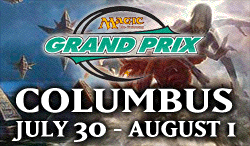The Grand Prix is closing in, and everyone is looking for a leg up. Obviously, you don’t have time to test the hundreds of match-ups in Legacy, so it’s lucky that hundreds of players have already done it for you. Check out the match-ups below and you will be ready for anything the GP can throw at you.
Since set rotation has a lower impact on Legacy and I had generally fewer results, I have included results back to our event in Richmond. This gives us over 1450 decks and over 8500 results to comb through. Combining all of these spreadsheets also gives us enough results in the .500+ sheet to pull some interesting data.
A couple things to keep in mind:
– The spreadsheet includes all of the results from the StarCityGames.com Legacy Opens in Richmond, Indianapolis, Orlando, Atlanta, Philadelphia, Seattle, and St. Louis.
– During the standardization of Archetype names, many minor archetypes have been eliminated and reclassified. Many of these changes were simply to match current Archetype names.
– Many sub-archetypes that were not consistently tracked (Number of land played in 43 Land) were eliminated.
– The 12+ versus 12+ and 15+ versus 15+ sheets have been combined to a .500+ versus .500+ worksheet. With 342 lists and almost 1400 results, there is some very interesting data, especially for the top archetypes.
Let’s look at the spreadsheet.
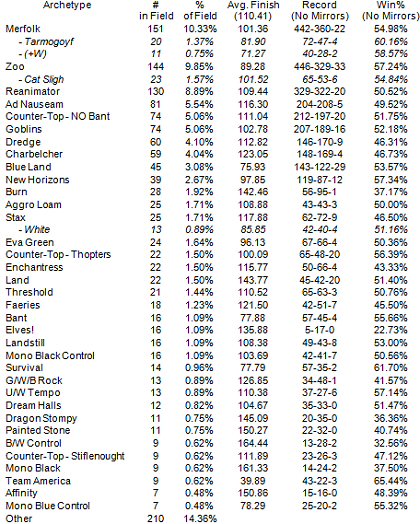
In a very diverse format Zoo, Mefolk, and Reanimator are clearly the favorite decks. Merfolk and Zoo put up consistently strong numbers throughout the season, and they also continue to be jumping on points for newer Legacy players. Fairly straightforward and definitely strong metagame choices, it is tough to argue with either of the deck’s results. Reanimator and Ad Nauseam have not put up the numbers that one might expect to lead to getting a card banned. Both hover around 50% win percentage and neither posted an impressive average finish. Further down the table, you can find a few decks that clearly deserve to be played more — Survival, U/W Tempo, and Team America put up excellent numbers, but none cracked 1% of the field. If you are looking for a rogue strategy to play at the GP that many people will not have tested against, any of those decks would fit the bill.
A quick explanation of the .500+ spreadsheet; I find all of the matches that are played between players that finish with a record that is at least 1 match over .500. For example, in a nine round event, this sheet will only include matches between players that finished with 15 or more points. (5 wins) In theory, this pinpoints the best decks and players and gives higher quality results by only taking matches into account where both players meet these criteria. I include this sheet in each event spreadsheets, but I rarely do much analysis on it due to the limited number of matches. For the Legacy .500+ table, I have also included % Penetration which measures the percentage of players of that archetype that achieved a .500+ record.
Archetypes in bold do not appear in the table above due to constituting less than 0.5% of the field.
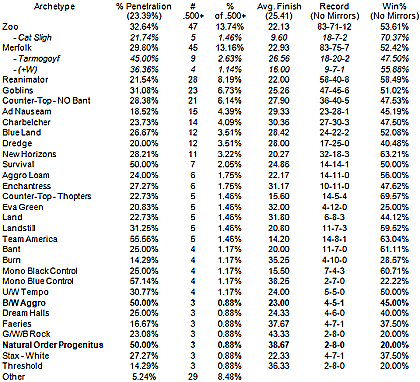
The most striking thing about the .500+ spreadsheet is how it beats the wheat from the chaff. Fourteen percent of the field is classified as “Other,” or decks with less than 0.5% representation, but those decks only constitute 9.36% of the .500+ spreadsheet. (Including the two “new” archetypes and adjusting for archetypes that “fell off.”) Here are the rogue strategies that managed to finish with a .500+ record:
Aluren — 1
Angel Stompy — 1
Counter-Top (Various Sub-Archetype) — 5
Helm of the Void — 1
Imperial Painter — 2
Jedi Emreka — 2
Life — 2
Painted Stone — 1
Scepter Chant — 2
Slivers — 1
Stiflenought (Show and Tell) — 1
Sui-Black — 1
Tezzerator — 1
Trinket Control — 1
U/W Control — 1
White Weenie — 1
Wizards — 1
A couple of these were one-event wonders like Jedi Emreka, but they may be worth taking a look at as new takes on the format.
Counter-Top Thopters makes a pretty good case for being one of the top decks in Legacy. The combo of Thopter Foundry and Sword of the Meek drove Extended players crazy and it looks like it may be time for Legacy players to start really gearing up against the deck. Other decks that outperformed their normal numbers when the top players faced off include Reanimator, New Horizons, and Landstill. Team America did not outperform its stellar 65% win percentage overall, but still notched a very strong 63%, confirming that it is definitely a deck to watch. It is also worth noting that, while both Merfolk and Zoo slipped a bit against the top opponents, the Cat Sligh sub-archetype of Zoo posted a ridiculous 70% win percentage between the top performers.
Merfolk — 10.33% of the Field — Won 54.98% of Matches
(.500+ – 13.16% of the Field — Won 52.42% of Matches)
Example:
Standard Build: Alex Bertoncini — 2nd Place — St. Louis, MO
Tarmogoyf Build: Kevin Ambler — 4th Place — Seattle, WA
(+W) Build: Brett Baugh — 9th Place — Seattle, WA
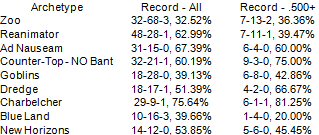
Zoo and Goblins are clearly the primary concern for Merfolk with both match-ups below the 40% mark. Both improve in the .500+ numbers, suggesting that it tightens up when played correctly, but not by much. With strong match-ups, Reanimator and Ad Nauseam, expected to see their numbers decline and a GP field that should be flooded with Zoo, I would recommend staying away from the fish in Columbus.
Zoo — 9.85% of the Field — Won 57.24% of Matches
(.500+ – 13.74% of the Field — Won 53.61% of Matches)
Example:
Standard Build: John McFadden — 3rd Place — Seattle, WA
Cat Sligh Build: Matt Smith — 2nd Place — Seattle, WA
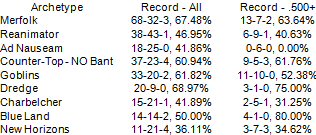
Zoo looks like it is poised to take over the metagame in Columbus. Tough match-ups Reanimator and Ad Nauseam both suffer greatly from the loss of Mystical Tutor and Zoo posted exceptional numbers against the other 4 top decks. The New Horizons match-up could prove a problem if the deck picks up steam and shows up in higher numbers in Columbus. However, I expect the GP to be filled with Zoo decks, so make sure that no matter what you play, you tune up to beat fast guys backed up by burn.
Reanimator — 8.89% of the Field — Won 50.52% of Matches
(.500+ – 8.19% of the Field — Won 58.49% of Matches)
Example:
Standard Build: Luis Scott-Vargas — 5th Place — Seattle, WA
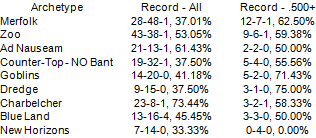
Reanimator is the only popular deck that actually performed better when the top players faced off, in fact turning the Merfolk match-up on its head and changing Goblins and Dredge from tough opponents into positive match-ups. It looks like there is a major disconnect between the top Reanimator players and those who were not able to get good results, as almost every major match-up changes drastically. It will be interesting to see if those players can help the deck survive the loss of Mystical Tutor.
Ad Nauseam — 5.54% of the Field — Won 49.52% of Matches
(.500+ – 4.39% of Field — Won 45.19% of Matches)
Example:
Standard Build: Eric Mason — 6th Place — Philadelphia, PA
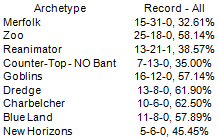
It is interesting that this deck has had as much success as it has. The match-ups seem to dictate that it would run into a wall at some point in the day, with sub 40% win percentages against three of the top four decks. If this deck was ever truly tier 1, with the loss of Mystical Tutor, it has clearly slipped to the second level.
Counter-Top — NO Bant — 5.06% of the Field — Won 51.75% of Matches
(.500+ – 6.14% of the Field — Won 47.53% of Matches)
Example:
NO Bant Build: Jim Orr — 2nd Place — Philadelphia, PA
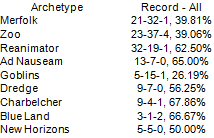
As the dominant Counter-Top variant, you would think that NO Bant would have some gaudy numbers to back that up. Unfortunately, the deck seems to be a major underdog to all of the aggressive decks in the format, losing to Goblins, Merfolk and Zoo at an alarming pace. Packing the full set of Force of Wills and repeatable counter magic, this deck is clearly a terror against combo and it shows with heavily favorable match-ups against Reanimator, Ad Nauseam and Charbelcher. I would stay away from this deck at the GP as I expect Zoo and Merfolk to maintain, or even increase, their presence in the metagame.
Goblins — 5.06% of the Field — Won 52.18% of Matches
(.500+ – 6.73% of the Field — Won 51.02% of Matches)
Example:
Standard Build: William Laycraft — 10th Place — Seattle, WA
(+B) Build: Noah Swartz — 5th Place — St. Louis, MO
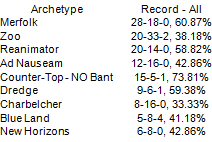
Goblins is a deck that surprised me with how well it has done. I always thought of it from the Onslaught days in Standard, but Legacy Goblins is so much more. Adding Black gives the deck access to a tutorable Edict effect as well as Perish out of the board so it is not hard to figure out why the (+B) build has become dominant. The deck has some great resiliency off Goblin Ringleader, and Siege-Gang Commander packs great finishing power.
The Big Finish
So, the question on everyone’s mind is “What should I play at the GP?” Well, here’s my answer: how about two decks?
If you don’t have a ton of time to test, pick up Team America; (Ryan Roeker — 9th Place — St, Louis, MO) dumb name, but a great deck. My second choice in this category would be Zoo, but if you play it, wear a shirt with a large bullseye on it. Every player who is aware of the metagame will be bringing a way to beat you.
If you have the time to test and are looking for something more involved, play Survival of the Fittest, (Ben Jensen — 7th Place — Seattle, WA) but be aware that the deck offers you many more mistakes to make, so familiarity with the deck and your match-ups is key to success.
Whatever you bring to the table, most of all, have fun! I will be at the GP helping a top notch Judge Staff keep it fair and keep it fun, so I hope to see you all there!

